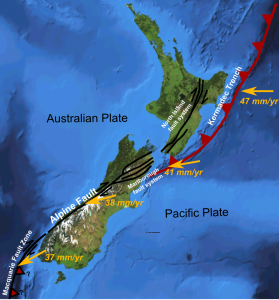8 March 2016
New Zealand’s Alpine Fault biggest mover in the world
Posted by Lauren Lipuma
by Samantha Fisher
New Zealand’s Alpine Fault has moved more in the last 25 million years than any other known land fault on Earth, according to new research from the Victoria University of Wellington and GNS Science.

New research that New Zealand’s Alpine Fault has moved more in the last 25 million years than any other known land fault on Earth.
Credit: Mikenorton via Creative Commons.
The findings reveal that over this time period, the two sides of South Island have shifted relative to each other more than 700 kilometers (435 miles) along the Alpine Fault, dramatically changing the understanding of New Zealand’s tectonic movements.
The next largest known fault displacement on land is on the Altyn Tagh Fault in Tibet, with a total movement of about 475 kilometers (295 miles) over the same time period, according to the study’s authors.
“It was widely accepted that the Alpine Fault had shifted 450 kilometers [280 miles] over time, based on the offset of distinctive rocks either side of the fault,” said Simon Lamb, associate professor at Victoria’s School of Geography, Environment and Earth Sciences and lead author of the new study. “But according to evidence found in the nature of the ocean floor, we knew the shift should be much larger.”
It had been thought that the answer might lie in the shape of the belts of rock that run across New Zealand, starting south of Dunedin and curving up to the Alpine Fault, twisting and stretching over time, Lamb said. But nobody had been able to prove it.
“By simply looking at it another way—at geological maps of New Zealand together with studies of the direction of magnetization in the rocks—we discovered that the missing displacement was actually on the Alpine Fault itself,” he said.
Instead of a 450-kilometer (280-mile) shift, the new findings show that the Alpine Fault moved 700 kilometers (435 miles) over the last 25 million years.
“The key to this new understanding is the realization that the rocks had actually shifted about 250 kilometers (155 miles) in the opposite direction prior to this, and so to make up for this, the younger motion is much bigger than we had thought,” Lamb said. “At this time, New Zealand was part of Antarctica and Gondwana.
“I don’t think anybody in their wildest dreams would have thought that displacements on the fault could be so large, and also change direction so dramatically through time,” he continued.
The findings, recently published in the American Geophysical Union journal Geochemistry, Geophysics, Geosystems, bring new light to our understanding of plate movements, Lamb said.
“It’s a great demonstration of the power of plate tectonics as it offers answers to a bigger puzzle about what happened in Antarctica over 65 million years ago, on the other side of an ocean from New Zealand and when dinosaurs roamed,” he said. “It may also have implications for why the Alpine Fault is the main hazard for earthquakes in South IsIand.”
— Samantha Fisher is a communications advisor at Victoria University of Wellington. This post originally appeared as a press release on the VUW website.










 GeoSpace is a blog on Earth and space science, managed by AGU’s Public Information staff. The blog features posts by AGU writers and guest contributors on all sorts of relevant science topics, but with a focus on new research and geo and space sciences-related stories that are currently in the news.
GeoSpace is a blog on Earth and space science, managed by AGU’s Public Information staff. The blog features posts by AGU writers and guest contributors on all sorts of relevant science topics, but with a focus on new research and geo and space sciences-related stories that are currently in the news.